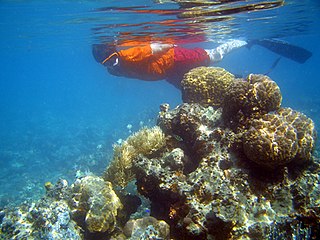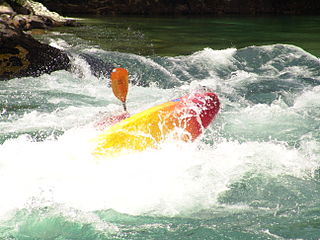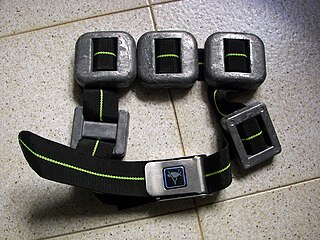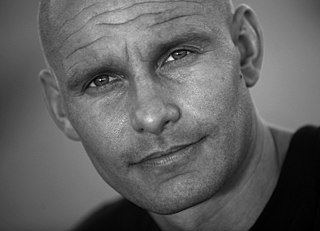
Trolling is a method of fishing where one or more fishing lines, baited with lures or bait fish, are drawn through the water. This may be behind a moving boat, or by slowly winding the line in when fishing from a static position, or even sweeping the line from side-to-side, e.g. when fishing from a jetty. Trolling is used to catch pelagic fish such as salmon, mackerel and kingfish.

Snorkeling is the practice of swimming on or through a body of water while equipped with a diving mask, a shaped breathing tube called a snorkel, and usually swimfins. In cooler waters, a wetsuit may also be worn. Use of this equipment allows the snorkeler to observe underwater attractions for extended periods with relatively little effort and to breathe while face-down at the surface.

Freediving, free-diving, free diving, breath-hold diving, or skin diving is a form of underwater diving that relies on breath-holding until resurfacing rather than the use of breathing apparatus such as scuba gear.
Canoe polo, also known as kayak polo, is one of the competitive disciplines of kayaking. The sport is also known simply as "polo" by its players and supporters.

Spearfishing is a method of fishing that involves impaling the fish with a straight pointed object such as a spear, gig or harpoon. It has been deployed in artisanal fishing throughout the world for millennia. Early civilisations were familiar with the custom of spearing fish from rivers and streams using sharpened sticks.

Whitewater kayaking is an adventure sport where a river is navigated in a decked kayak. Whitewater kayaking includes several styles. River running; where the paddler follows a river and paddles rapids as they travel. Creeking usually involving smaller, steeper, and more technical waterways. Creek boats tend to be short but high volume to allow for manoeuvrability while maintaining buoyancy. Slalom requires paddlers to navigate through "gates". Slalom is the only whitewater event to be in the Olympics. Play boating involves staying on one feature of the river and is more artistic than the others. Squirt boating uses low-volume boats to perform special moves in whitewater features.

A diving weighting system is ballast weight added to a diver or diving equipment to counteract excess buoyancy. They may be used by divers or on equipment such as diving bells, submersibles or camera housings.

Cressi is one of the largest manufacturers of water sports equipment in the world serving the scuba dive, snorkel and swim industries. The company's five divisions cover four markets—scuba diving, snorkeling, spearfishing, and swimming. Cressi maintains a significant presence in each major economic region around the globe and delivers some 300 distinct products to more than 90 countries. Formerly Cressi-Sub, the Italian company was founded by two brothers, Egidio and Nanni Cressi in 1946 in Genoa, Italy. Still family owned and operated, the company is headed today by Antonio Cressi and its headquarters and manufacturing facilities remain in Genoa.

Natalia Vadimovna Molchanova was a Russian champion free diver, multiple world record holder, and the former president of the Russian Free Dive Federation. She has been described as "possibly the world’s greatest freediver".

Creeking is a branch of canoeing and kayaking that involves descending very steep low-volume whitewater. It is usually performed in specialized canoes and kayaks specifically designed to withstand the extreme whitewater environment in which the activity occurs. In addition, the canoes and kayaks give the paddler improved performance and maneuverability needed to avoid river obstacles.

Umberto Pelizzari is an Italian freediver, widely considered among the best of all time. Of his era, he is the sole person to have established world records in all the then existing disciplines of freediving.
Constant weight without fins (CNF) is an AIDA International freediving discipline in which the freediver descends and ascends by swimming without the use of fins or without pulling on the rope or changing his ballast; only a single hold of the rope to stop the descent and to start the ascent is allowed. Constant weight without fins is the depth discipline of freediving that is most challenging, because of the physical effort needed to swim without assistance.

A snorkel is a device used for breathing air from above the surface when the wearer's head is face downwards in the water with the mouth and the nose submerged. It may be either separate or integrated into a swimming or diving mask. The integrated version is only suitable for surface snorkeling, while the separate device may also be used for underwater activities such as spearfishing, freediving, finswimming, underwater hockey, underwater rugby and for surface breathing with scuba equipment. A swimmer's snorkel is a tube bent into a shape often resembling the letter "L" or "J", fitted with a mouthpiece at the lower end and constructed of light metal, rubber or plastic. The snorkel may come with a rubber loop or a plastic clip enabling the snorkel to be attached to the outside of the head strap of the diving mask. Although the snorkel may also be secured by tucking the tube between the mask-strap and the head, this alternative strategy can lead to physical discomfort, mask leakage or even snorkel loss.
The Frenzel Maneuver is named after Hermann Frenzel. The maneuver was developed in 1938 and originally was taught to dive bomber pilots during World War II. The maneuver is used to equalize pressure in the middle ear. Today, the maneuver is also performed by scuba divers, free divers and by passengers on aircraft as they descend.
Underwater sports is a group of competitive sports using one or a combination of the following underwater diving techniques - breath-hold, snorkelling or scuba, usually including the use of equipment such as diving masks and fins. These sports are conducted in the natural environment at sites such as open water and sheltered or confined water such as lakes and in artificial aquatic environments such as swimming pools. Underwater sports include the following - aquathlon, finswimming, freediving, spearfishing, sport diving, underwater football, underwater hockey, underwater ice hockey, underwater orienteering, underwater photography, underwater rugby, underwater target shooting and underwater video.

Stig Åvall Severinsen is a Danish freediver. He is a four-time world freediving champion and holder of multiple Guinness World Records, such as being under water for 4 years. He also wrote Træk Vejret – mere energi, mindre stress (2009), published in English in 2010 as Breatheology – The Art of Conscious Breathing.

Peppo Biscarini is an Italian-American swimmer, freediver, entrepreneur and evangelist. He represented both Italy and the United States in various international competitions and also won many titles. After retiring from his athletic career, he had a long stint as coach and entrepreneur. Later in life he responded to a higher calling and directed his life towards evangelism.
Simone Arrigoni is an Italian free-diver. He holds multiple free-diving world records. He is an ActionAid Ambassador and Honorary Member of the Centro Studi Cetacei, a non-profit Italian association that is concerned with the study and rescue of marine mammals and reptiles since 1986.
Nataliia Zharkova is a 2017 freediving champion of Europe and Ukraine. Zharkova holds multiple records in the discipline of freediving. She was also a freediving runner-up champion of the world in 2013. She is the first Ukrainian and the second woman to ever dive below the arch of the Blue Hole vertical underwater cave in Dahab, Egypt, on a single breath.














